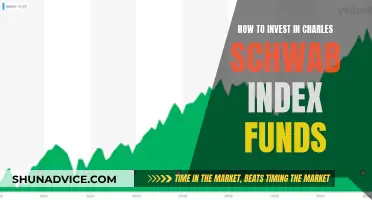
Index funds are a great way to build wealth over time, especially for retirement investors. They are a group of stocks that mirror the performance of an existing stock market index, such as the Standard & Poor's 500. An index fund will be made up of the same investments that make up the index it tracks, so the performance of the index fund usually closely mirrors that of the index. Index funds are considered a passive management strategy because they don't need to actively decide which investments to buy or sell. They are also a low-cost option for investors as they are cheap to run since they are automated to follow the shifts in value in an index.
There are several investment apps available that can be used to invest in index funds. Some of the best investment apps for beginners include SoFi Invest, Acorns Invest, Ally Invest, and Public Investing. These apps offer low fees, educational resources, and simple trading, making them ideal for those new to investing.
What You'll Learn

Picking the right app
When it comes to choosing an investment app, there are several factors to consider. Here are some key points to keep in mind:
- Fees and costs: Investment apps can vary significantly in terms of fees and costs. Some apps offer commission-free trading, while others may charge higher fees for certain transactions. It's important to understand the fee structure and how it might impact your returns.
- Ease of use and functionality: Look for an app that is easy to use and navigate, with a user-friendly interface. Consider the features that are important to you, such as real-time market data, custom stock alerts, and investment tracking tools.
- Account options: Different apps offer different types of accounts, such as individual investment accounts (ISAs), self-invested personal pensions (SIPPs), and general investment accounts (GIAs). Choose an app that offers the account type that aligns with your investment goals and preferences.
- Investment options: Consider the range of investment options available on the app. Some apps offer a diverse selection of assets, including stocks, bonds, ETFs, mutual funds, and sometimes cryptocurrencies. Others may focus on specific types of investments, such as ETFs or socially responsible investments. Choose an app that offers the investment options that match your interests and risk tolerance.
- Reputation and security: It's important to choose an app that is authorised and regulated by the relevant financial authorities, ensuring the safety of your investments. Read reviews and user feedback to get a sense of the app's reputation and security features, such as two-factor authentication and secure encryption technology.
- Customer support: Look for an app that provides reliable customer support to assist you with any questions or issues you may have. This can be especially important for beginners who may need more guidance when starting their investment journey.
- Suitability for beginners: If you're new to investing, look for an app that offers educational resources, guides, and tools to help you learn and make informed decisions. Some apps are specifically designed for beginners, while others may be more suitable for more experienced investors.
- Performance and reviews: Consider the performance and track record of the investment app. Look at the returns generated by the app's investment strategies and compare them with other options. Check reviews and testimonials from users to get a sense of their experience and level of satisfaction with the app.
Remember to evaluate your own investment goals, risk tolerance, and preferences when selecting an investment app. What works for someone else may not necessarily be the best choice for you. Taking the time to research and compare different apps will help you make a more informed decision.
The Mindset of Investment Fund Managers: Traits and Insights
You may want to see also

Setting up an account
Setting up an investment account is easy. Here's a quick rundown of how to do it:
- Have a goal for your index funds: Before you start investing in index funds, it's important to know what you want your money to do for you. If you're looking for a short-term place to park your money and earn a bit of interest, you may be more interested in certificates of deposit, savings accounts or money market funds. But if you're looking to let your money grow slowly over time, particularly if you're saving for retirement, index funds may be a great investment for your portfolio.
- Research index funds: Once you know what index you want to track, it's time to look at the actual index funds you'll be investing in. When you're investigating an index fund, it's important to consider several factors, including company size and capitalization, geography, business sector or industry, asset type, and market opportunities.
- Pick your investment app: You'll need to choose an investment app or brokerage to purchase your index funds from. Some popular options include eToro, InvestEngine, Plus500, Freetrade, Nutmeg, Moneybox, Interactive Investor, AJ Bell, Hargreaves Lansdown, IG, Wealthify, Plum, Moneyfarm, Wombat, and Trading 212. When choosing an app, consider factors such as fees, user experience, account options, features, and security.
- Decide where to buy your index funds: You can purchase an index fund directly from a mutual fund company or a brokerage. When choosing where to buy, consider factors such as fund selection, convenience, trading costs, impact investing options, and commission-free options.
- Open an investment account: To purchase shares of an index fund, you'll need to open an investment account. A brokerage account, individual retirement account (IRA), or Roth IRA will all work. Compare different options and choose the one that best suits your needs and preferences.
- Fund your account: Decide how much money you want to invest and transfer funds from your bank to your investment account. You can also set up automatic recurring contributions to make regular investments.
- Purchase your index funds: Once your account is funded, you can purchase shares of the index fund you've selected. You may be able to select a fixed dollar amount to spend or choose a number of shares to buy.
Retirement Mutual Funds: Choosing the Right Investment for Your Future
You may want to see also

Funding your account
Funding your brokerage account is a crucial step in investing in index funds. Here's a detailed guide on funding your account:
Choose a Brokerage Account:
Select a brokerage firm that aligns with your investment goals and preferences. Research the fees, investment choices, and ease of use offered by different brokerage firms before making a decision.
Open an Account:
Go to the website of your chosen brokerage firm and follow the instructions to open an account. You will need to provide personal information and link your bank account to fund your investments. Some common types of accounts include brokerage accounts, individual retirement accounts (IRAs), and Roth IRAs.
Decide on a Funding Method:
You can fund your brokerage account by transferring money from your linked bank account. You may also have the option to set up automatic recurring contributions on a weekly, biweekly, or monthly basis. This helps ensure that you consistently add funds to your investments.
Understand the Minimum Requirements:
Different brokerage firms and investment options may have varying minimum investment requirements. For example, some index funds may have minimum initial investment amounts set by the mutual fund provider. Make sure you review these requirements before funding your account.
Consider the Costs:
When funding your brokerage account, be mindful of the costs involved. Brokerage accounts may charge various fees, such as management fees or transaction fees. These fees can impact your overall investment returns, so it's important to factor them into your decision-making.
Start with a Comfortable Amount:
You don't need a large sum of money to start investing in index funds. You can begin with a small amount and gradually increase your investments over time. The key is to develop a consistent saving and investing discipline.
Remember, investing in index funds offers a great opportunity to build wealth over the long term. By choosing the right brokerage account, understanding the costs, and funding your account regularly, you can set yourself up for success in achieving your financial goals.
Closed-End Funds: Smart Investment, Smart Returns
You may want to see also

Exploring investment options
High-yield savings accounts
High-yield savings accounts are offered by online banks and tend to provide higher interest rates compared to traditional savings accounts. They are a great option for those seeking to boost their returns on savings while still having regular access to their money.
Certificates of Deposit (CDs)
CDs are a type of savings account that offer higher interest rates than regular savings accounts but require you to keep your money locked up for a fixed period, such as six months, a year, or even five years. Withdrawing your money before the maturity date typically results in a penalty.
401(k) or Workplace Retirement Plan
A 401(k) is a popular retirement savings plan offered by employers, who often match a portion of their employees' contributions. This means you get free money from your employer, making it an attractive option for those looking to save for retirement. Contributions to a traditional 401(k) are made before taxes, allowing your money to grow tax-free until retirement. Some employers also offer Roth 401(k)s, which are taxed differently.
Mutual Funds
Mutual funds allow you to invest in a diversified basket of stocks, bonds, or other assets. They are managed by professionals and often have minimum investment requirements ranging from $500 to $5,000, although some funds have no minimum at all. Mutual funds provide an easy way to gain exposure to a large number of stocks or other investments in a single transaction.
Exchange-Traded Funds (ETFs)
ETFs are similar to mutual funds but trade on stock exchanges throughout the day. They typically track a market index, such as the S&P 500, and have lower fees than mutual funds. ETFs are bought and sold at a share price, which can range from under $100 to $300 or more, depending on the fund.
Individual Stocks
Investing in individual stocks is the riskiest option on this list but can also offer potentially higher rewards. When buying stocks, it's important to consider your investment horizon and whether you understand the business you're investing in. Stocks are best suited for long-term investment goals, as their prices can be volatile in the short term.
These are just a few of the many investment options available. It's important to consider your financial goals, risk tolerance, and time horizon before making any investment decisions. Diversification is also key to reducing risk and maximizing returns.
How to Choose the Right Managed Funds
You may want to see also

Building your portfolio
- Define your investment goals: Before you begin investing, it's important to understand what you want to achieve. Are you investing for the short-term or long-term? Do you want to build wealth over time or generate income? Having clear goals will help you determine the right investment strategies and assets to include in your portfolio.
- Diversify your investments: Diversification is a key principle in investing. By spreading your investments across different asset classes, sectors, and geographic regions, you can reduce risk and potentially increase your returns. Consider investing in a mix of stocks, bonds, ETFs, mutual funds, and other assets to build a well-diversified portfolio.
- Consider your risk tolerance: Different investments come with different levels of risk. It's important to assess your risk tolerance and choose investments that align with your comfort level. If you're comfortable with higher risk, you may consider investing in more volatile assets. If you prefer a more conservative approach, you might opt for less risky investments.
- Research and compare investment options: There are numerous investment options available, including stocks, bonds, ETFs, mutual funds, and more. Research and compare the performance, fees, and risks associated with each investment option before adding them to your portfolio. Diversification across asset classes and sectors can help manage risk.
- Monitor and rebalance your portfolio: Regularly review the performance of your investments and make adjustments as needed. Over time, some investments may outperform others, causing your portfolio to become unbalanced. Rebalancing involves buying or selling assets to return your portfolio to your desired allocation. This helps ensure your portfolio remains aligned with your investment goals and risk tolerance.
- Consider working with a financial advisor: Building an investment portfolio can be complex, especially for beginners. Consider seeking guidance from a financial advisor or investment professional. They can help you assess your financial situation, define your investment goals, and create a customized investment plan.
Vanguard Index Funds: Best Bets for Your Money
You may want to see also
Frequently asked questions
An index fund is a group of stocks that aims to mirror the performance of an existing stock market index, such as the S&P 500. An index fund will be made up of the same investments that make up the index it tracks.
When choosing an index fund, consider the fund's performance, cost, and limitations. Also, check if the fund provider has other index funds that you may be interested in.
You can buy an index fund through a brokerage or directly from a mutual fund company. You will need to open an investment account, such as a brokerage account, IRA, or Roth IRA.
The minimum amount needed to invest in an index fund depends on the fund and the broker's policies. Some brokers allow you to buy fractional shares, which can lower the minimum investment amount.







